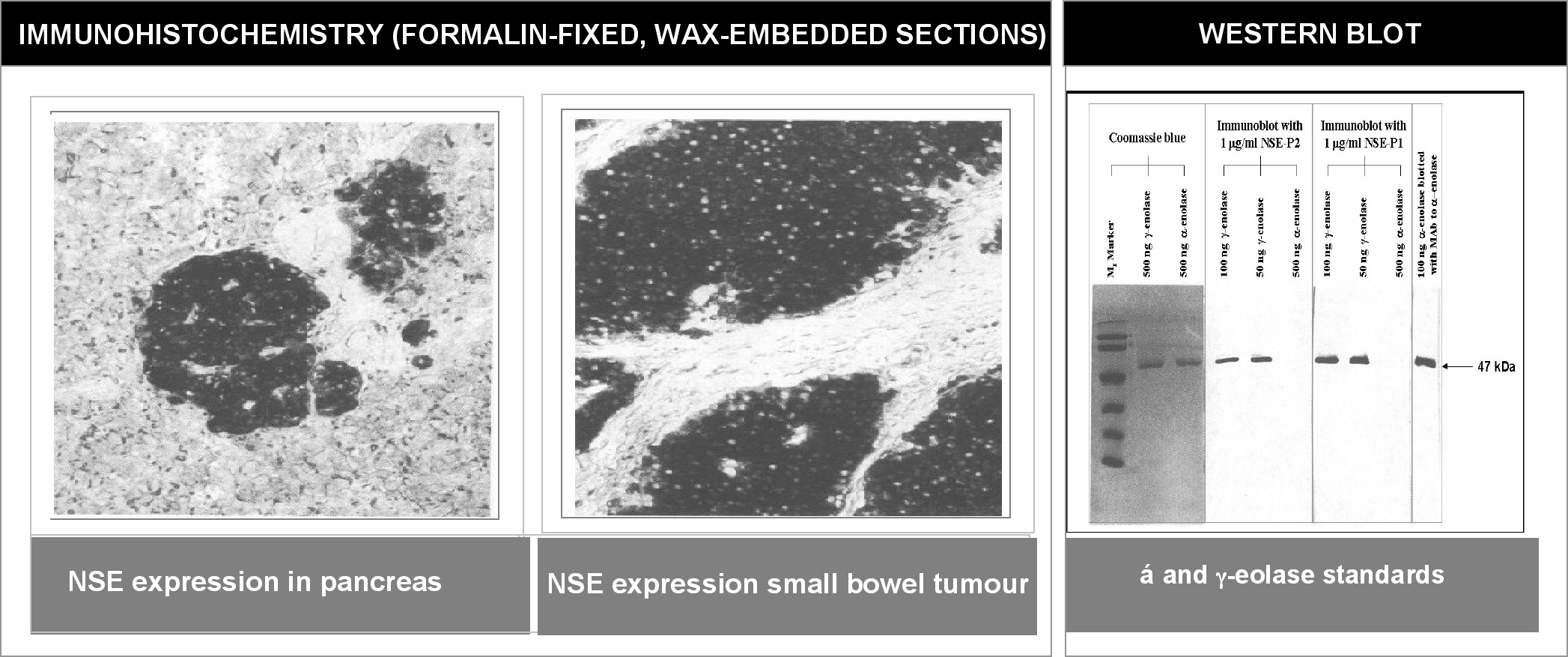Catalogue

Mouse anti Human Enolase
Catalog number: X2070M| Clone | NSE-P1 |
| Isotype | IgG1 |
| Product Type |
Monoclonal Antibody |
| Units | 200 µg |
| Host | Mouse |
| Species Reactivity |
Chicken Human Mouse |
| Application |
ELISA Immunohistochemistry Western Blotting |
Background
Enolases have been characterized as highly conserved cytoplasmic glycolytic enzymes that may be involved in differentiation. Three isoenzymes have been identified, Enolase, Enolase and Enolase. Enolase expression has been detected on most tissues, whereas Enolase is expressed predominantly in muscle tissue and Enolase is detected only in nervous tissue. These isoforms exist as both homodimers and heterodimers, and they play a role in converting phosphoglyceric acid to phosphenolpyruvic acid in the glycolytic pathway.
Synonyms: ENO2; Enolase 2, (gamma, neuronal); 2-Phospho-D-Glycerate Hydrolase
Source
Immunogen: Hybridoma produced by the fusion of splenocytes from BALB/c mice immunized with a synthetic peptide derived from the human NSE protein and mouse myeloma Ag8563 cells. Sequence common in human, mouse and chicken.
Product
Product Form: Unconjugated
Formulation: Provided as solution in phosphate buffered saline with 0.08% sodium azide
Purification Method: Protein A/G Chromatography
Concentration: See vial for concentration
Applications
Antibody can be used for Western blotting (1-2 µg/ml) and immunohistochemistry on formalin-fixed, paraffin-embedded tissue sections (1-5µg/ml). Optimal concentration should be evaluated by serial dilutions.
Functional Analysis: Western Blotting
Positive Control: Serum, brain, pancreas, liver, skeletal muscle and endocrine tumors. Expression stronger in tumor versus normal tissue.
Storage
Product should be stored at -20°C. Aliquot to avoid freeze/thaw cycles
Product Stability: See expiration date on vial
Shipping Conditions: Ship at ambient temperature, freeze upon arrival
Caution
This product is intended FOR RESEARCH USE ONLY, and FOR TESTS IN VITRO, not for use in diagnostic or therapeutic procedures involving humans or animals. It may contain hazardous ingredients. Please refer to the Safety Data Sheets (SDS) for additional information and proper handling procedures. Dispose product remainders according to local regulations.This datasheet is as accurate as reasonably achievable, but Nordic-MUbio accepts no liability for any inaccuracies or omissions in this information.
References
1. Kang, J.L., et al. (1996). Immunoreactive neuron-specific enolase (NSE) is expressed in testicular carcinoma-in-situ. J. Pathol. 178(2):161-165.
2. Koch, M., et al. (2007). Plasma S100beta and NSE levels and progression in multiple sclerosis. J. Neurol. Sci. 252(2):154-158.
3. Oertel, M., et al. (2006). S-100B and NSE: markers of initial impact of subarachnoid haemorrhage and their relation to vasospasm and outcome. J. Clin. Neurosci. 13(8):834-840.
Protein Reference(s)
Database Name: UniProt
Accession Number: P09104
Species Accession: Human
Safety Datasheet(s) for this product:
| NM_Sodium Azide |

"Left and Center: Immunohistochemical staining of normal pancreas tissue (left) and small bowel tumor tissue (center) using NSE antibody (X2070M and X2071M). Right: Western blot analysis using NSE antibodies (X2070M and X2071M) on α and γ enolase standards."

